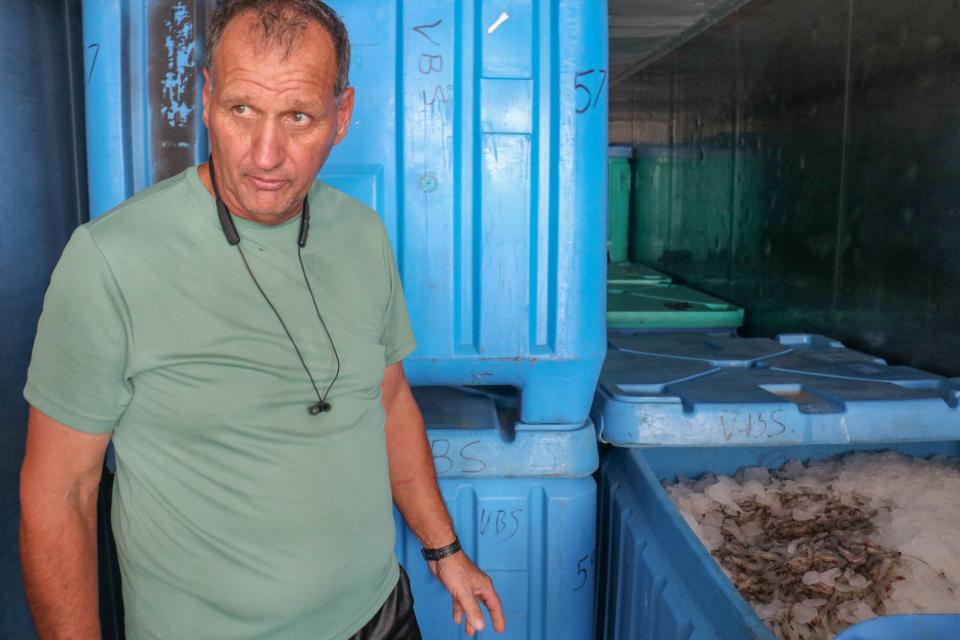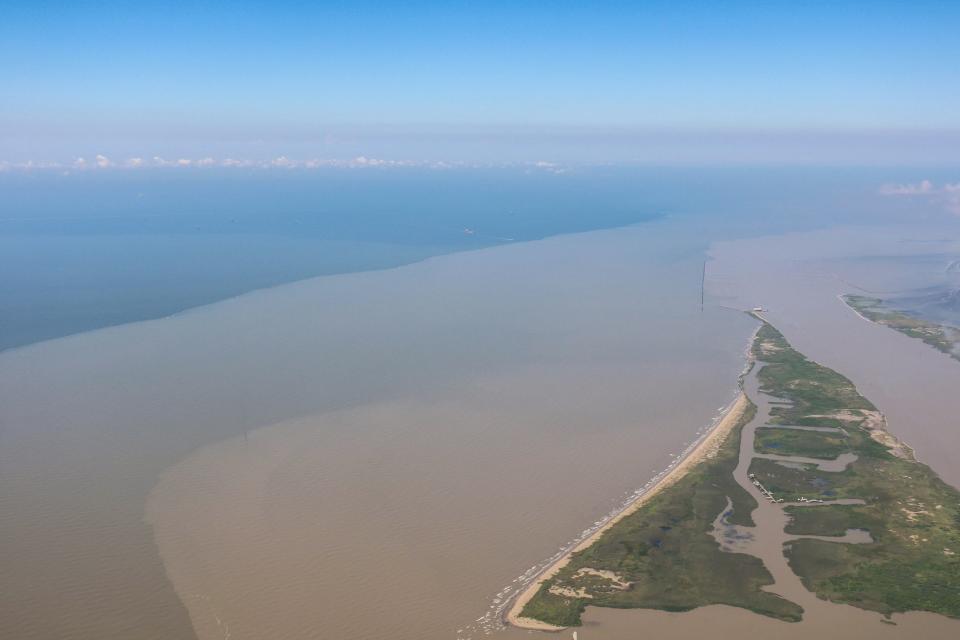Louisiana gets the worst of Mississippi River farm runoff. Why doesn’t it push for solutions?
CYPREMORT POINT, La. — Thomas Olander has watched his shrimp catch shrink over the last 15 years. It’s not just the abundance of Louisiana shrimp; Olander said the average size of the crustacean also has shrunk.
In the past, shrimpers could expect the crustaceans to grow throughout the spring season, which starts in May in Louisiana waters and generally runs through July. “Since we’ve been dealing with this ‘dead zone,’ we’re not seeing that growth anymore,” said Olander.
The dead zone is a stretch along the shallows of the Gulf of Mexico where algae blooms choke off oxygen in the water. Last month, the National Oceanic and Atmospheric Administration estimated that this summer’s dead zone would reach 5,827 square miles – an area roughly the size of Connecticut. That’s up from approximately 3,058 square miles in 2023.

These massive algae blooms are caused by nutrients that run off farms up and down the Mississippi River Basin, from Minnesota and Wisconsin down to the Gulf of Mexico.
Fertilizer that helps crops grow contains high levels of nitrogen and phosphorus. These nutrients run off the fields during rainstorms and end up in waterways leading to the Mississippi River.
The Gulf of Mexico Hypoxia Task Force was established in the fall of 1997 as a collaboration of state, federal and tribal agencies. A preliminary goal was to reduce both nitrogen and phosphorus by 20% by 2025. But despite some progress, meeting that goal is unlikely.
The 2025 target is simply not a priority, said Doug Daigle, a research scientist at Louisiana State University and coordinator of the Louisiana Hypoxia Working Group. Neither the task force nor Louisiana attempted to raise funds from Congress to implement programs that would reduce nutrient pollution.
In addition, the plan is hindered by a lack of enforceable limits on nitrogen and phosphorus, according to the Tulane Institute on Water Resources Law and Policy. Instead, it focuses on voluntary state efforts and guidelines.
To address the sheer quantity of nutrient pollution from the upriver basin states, Tulane lawyers suggest that Louisiana could petition the U.S. Environmental Protection Agency for greater enforcement under the Clean Water Act.
One section of the law allows for the government to set specific, maximum amounts of daily pollutants for bodies of water deemed to be impaired. Louisiana could petition the EPA to declare sections of the Mississippi River or the Gulf of Mexico as impaired, which would allow for the creation of an enforceable limit on nutrients entering the river upstream. Louisiana could also petition the EPA administrator to convene an interstate water management conference to address pollution upriver.
So far, Louisiana has not done any of this. Louisiana Gov. Jeff Landry’s office did not respond when asked if Landry has any plans to petition the EPA or address the growth of the dead zone.
Would redirecting the river make a difference?
Some critics say that the state focuses too heavily on plans to redirect the flow of the Mississippi River.
The Coastal Protection and Restoration Authority highlights the benefits that would come from plans to reconnect the river to land across the coast.

Angelina Freeman, a research scientist at CPRA, explained that by redirecting the river’s flow, nutrients that otherwise would have fueled the dead zone would instead nourish the state’s recovering wetlands.
A few man-made diversions are already up and running, such as the Caernarvon and Davis Pond Diversions. Davis Pond is restoring wetlands in the upper Barataria Basin on the west side of the Mississippi River near Luling, in St. Charles Parish, Louisiana, while Caernarvon delivers sediments and nutrients to Breton Sound on the river’s east bank in Plaquemines Parish.
The 2023 Louisiana Coastal Master Plan calls for redirecting sediments and nutrients into Barataria Bay on a massive scale through the largest single restoration project in U.S. history. The Mid-Barataria Sediment Diversion would build and nourish up to 27 square miles of coastal wetlands over the next 50 years.
But to Daigle, centering the state’s nutrient reduction and management strategy around sediment diversions is a mistake.
“Until (the diversions) are built and operating they don’t do anything, good or bad,” he added. “Talking about them doesn’t accomplish anything. Having them in a plan doesn’t accomplish anything.”
“The solution to pollution is not distribution,” said Nancy Rabalais, a professor at Louisiana State University.
Louisiana farmers beginning to take action themselves
While the vast majority of nutrients that create the dead zone every summer come from agriculture in the states upriver from Louisiana, there is still a significant input of runoff from farmland within the state itself.
Earlier this year, the Gulf of Mexico Alliance received a grant to help farmers in northeast Louisiana adopt practices to prevent excessive runoff from entering the Bayou Lafourche watershed, and ultimately the Red River and Atchafalaya Basin.
The Atchafalaya River siphons off 30% of the Mississippi River’s flow. The Atchafalaya has a growing delta system, such as at the Wax Lake Outlet, but excess nutrients still escape to the Gulf of Mexico, expanding the dead zone to the west.
In Morehouse Parish, farmers are being taught how to limit their contribution to nutrient runoff that would reach the Gulf through the Mississippi-Atchafalaya Basin. A grant will fund new farming techniques, including the subsidizing of cover crops to reduce runoff, which may also increase soil productivity and cash crop yields.
“We’re doing exactly what we hope and wish everyone north of us would be doing,” said Joey Breaux, assistant commissioner of the Louisiana Department of Agriculture and Forestry. He added that the farmers in Morehouse Parish have been very receptive to the new program.
The funds will go to help farmers plant cover crops between growing seasons to reduce soil erosion and prevent nutrients from running off into the river. The farmers will also receive instruction in no-till management, which calls for crops to be planted in narrow rows within the untilled seedbeds of previous crops. Keeping the soil intact increases organic matter and productivity while reducing the need for excess fertilizer.
Olander, the shrimper, said that he wishes the Department of Wildlife and Fisheries would support his industry’s losses in the way farmers are supported. “They are really keeping their farmers going,” he added. “Call me a farmer of the sea; I’ll take that title if they would help us.”
Delaney Dryfoos is a reporter at The (New Orleans) Lens. This story is part of the series Farm to Trouble from the Mississippi River Basin Ag & Water Desk, an independent reporting collaborative.
This article originally appeared on Milwaukee Journal Sentinel: Mississippi River farm runoff hurts Louisiana. Why is it accepting?

